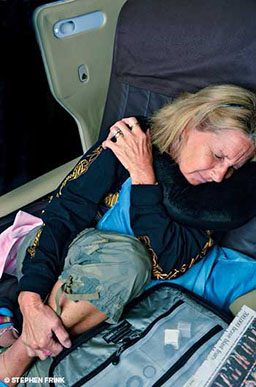The Diver
The diver was a 49-year-old female with more than 200 lifetime dives. She had no known medical history, took no medications regularly and was generally healthy and fit.
The Dives
Her trip was to a popular Caribbean island for a weeklong dive vacation. Over six days she completed 21 problem-free dives, all of which were on air and were within the no-decompression limits of her computer. She performed a safety stop at the end of each dive. The maximum depth of her deepest dive was 112 feet; the rest of the dives ranged from 30 to 90 feet deep. The diver refrained from excessive consumption of alcohol and other behaviors that might have negatively affected her health or safety while on vacation.
The Symptoms

On the day of her departure from the island, the diver’s preflight surface interval was greater than 24 hours. She had no specific complaints but did have a general sense of feeling unwell. During the first of her two flights she began to experience deep muscle and joint aches. The discomfort was in multiple areas and was accompanied by nausea and a severe headache. The symptoms did not resolve on the ground between flights, and they did not worsen during the second flight. She arrived home and hoped to recover by getting some rest. After a less-than-recuperative night’s sleep her symptoms did not diminish, and, concerned about the possibility of decompression sickness (DCS), she decided to contact DAN®.
The DAN medic to whom she spoke suggested that she seek medical attention at the closest emergency department. While the possibility of decompression injury could not be excluded, the timing and the nature of her symptoms made other possible explanations more likely. When she arrived at the emergency department she had a fever of 103°F. She underwent a variety of diagnostic procedures, including several laboratory tests and thorough physical and neurological examinations. All indications pointed to a diagnosis of dengue fever, not DCS.
The hospital staff administered appropriate supportive care, which included IV fluids and medications to help manage her pain and nausea. She was ultimately discharged, and the doctor instructed her family on how to monitor her condition and continue her care. The fever and nausea subsided within three days, and the aches and headache finally resolved after two weeks.
Discussion
This case should serve as a reminder that travel to tropical areas exposes divers to risks beyond those associated with diving. The timing and nature of this diver’s symptoms justifiably led her to suspect the symptoms may not have been related to diving. However, she wisely deferred to the expertise of medical professionals and, in doing so, received prompt evaluation and care for the illness she had. (It is worth noting that the established flying-after-diving guidelines are associated with a consistently high safety record.)
The importance of receiving a medical assessment that considers multiple possible diagnoses cannot be overstated. While localized pain and severe fatigue are common symptoms of DCS, generalized muscle pains and fever are not. The evaluating physician recognized this and expanded the differential diagnosis list accordingly. The diagnosis of dengue fever is made on the basis of clinical findings (signs and symptoms) as well as history of travel to known risk areas. Fortunately, this tropical disease is not generally life-threatening, and full recovery is expected within a few weeks, as occurred in this case.
Most divers are familiar with the signs and symptoms of DCS, but it is important to remember that these signs and symptoms are not exclusive to DCS and may indicate other maladies.
About Dengue
Dengue fever is a mosquito-borne infection. There is a documented rise in infection rates throughout the Caribbean and in the southeastern United States. Rates have not increased to an alarming level, but travelers should be aware of the disease. The infection is characterized by an acute onset of a fever three to 14 days after being bitten by an infected mosquito. The classic dengue fever presents, after this incubation period, as follows:
• Acute fever
• Muscle and joint aches/pain
• Severe frontal headache
• Acute pain behind the eyes
• Nausea and loss of appetite
• Rash
• In rare cases, bleeding
The pain associated with the disease can be severe, especially in subsequent infections. This severe pain gave rise to dengue’s nickname, “breakbone fever.” Medical care for infected people is aimed at symptom reduction, as there is no cure (nor is there a vaccine). The fever and pain should be managed with acetaminophen (Tylenol); avoid aspirin, ibuprofen, naproxen and other nonsteroidal anti-inflammatory drugs (NSAIDs) as these can promote bleeding.
In most cases the fever resolves within a few days, but fatigue may persist for days to weeks. To learn more about dengue and other tropical diseases, visit the website of the Centers for Disease Control and Prevention (www.cdc.gov) or the World Health Organization (www.who.int). As always, if you develop symptoms after diving, do not hesitate to contact DAN.
© Alert Diver — Q3 Summer 2013